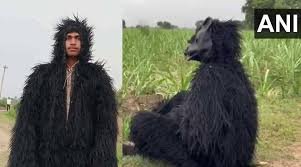Farmers in Uttar Pradesh Resort to Unique Strategy to Protect Crops from Monkeys
Introduction:
In a unique and innovative approach to tackle the problem of crop damage caused by monkeys, farmers in Uttar Pradesh have resorted to donning bear costumes. The increasing menace of monkeys and stray cattle wreaking havoc on their crops has left farmers desperate for effective solutions. Despite their appeals to the authorities falling on deaf ears, these farmers have taken matters into their own hands by pooling their resources to purchase a bear costume for protection. This article delves into the challenges faced by farmers, their ingenious solution, and the impact it has had on safeguarding their livelihoods.
The Plight of Farmers:
Farmers across India, including those in Uttar Pradesh, have long struggled with the issue of crop damage caused by animals. Monkeys, in particular, pose a significant threat to crops such as sugarcane, which is a vital source of income for many farmers in the region. Months of hard work invested in planting and nurturing crops can be rendered futile in a matter of hours when a group of monkeys descends upon a field. Despite farmers’ efforts to deter these animals using scarecrows and other methods, the relentless damage continues, causing immense financial losses and despair.
Desperate Measures:
Frustrated by the lack of attention from authorities, a group of farmers in Uttar Pradesh decided to take unconventional measures to protect their crops. With the aid of their collective contributions, they purchased a bear costume for approximately Rs 4,000. The idea was to create an illusion of a bear’s presence, which would ideally scare off monkeys and prevent them from destroying their sugarcane crop. Initially, one farmer and his son took turns wearing the costume while patrolling the fields. However, due to the demanding nature of the task, they eventually hired someone to perform this role on a daily basis.
The Bear Costume Solution:
By donning the bear costume and patrolling the fields, the hired individual serves as a visual deterrent to the monkeys. The aim is to instill fear in the primates, making them believe that a formidable predator is guarding the crops. Gajender Singh, one of the farmers involved, explained that approximately 40-45 monkeys were causing significant damage to their crops. Frustrated with the lack of attention from authorities, they decided to proactively address the problem. Singh and his fellow farmers took the initiative, realizing that protecting their livelihoods required creative thinking.
Impact on Crop Protection:
Since implementing this unconventional strategy, the farmers have witnessed promising results. The presence of the person in the bear costume has deterred monkeys from approaching the fields, reducing instances of crop damage. While the true effectiveness of this method may be subjective, it has provided a sense of relief and hope to the farmers who were previously disheartened by the relentless destruction of their hard work. Their investment in the bear costume and the daily wages paid to the individual wearing it are justified by the visible decrease in crop damage.
The Need for Long-Term Solutions:
While the bear costume solution may have provided temporary respite for the farmers in Uttar Pradesh, it is crucial to address the underlying issue of animal intrusion in a more sustainable manner. Farmers should not have to resort to such creative yet unconventional methods to protect their crops. Authorities need to recognize the gravity of the situation and collaborate with farmers to develop long-term strategies. Effective measures such as fencing, enhanced surveillance, and the introduction of more comprehensive animal control programs should be explored to mitigate the economic losses suffered by farmers.
Conclusion:
The plight of farmers battling crop damage caused by monkeys and stray cattle is a widespread issue in India. The unique approach taken by farmers in Uttar Pradesh, by donning bear costumes to protect their sugarcane crops, highlights the desperation and innovation .









